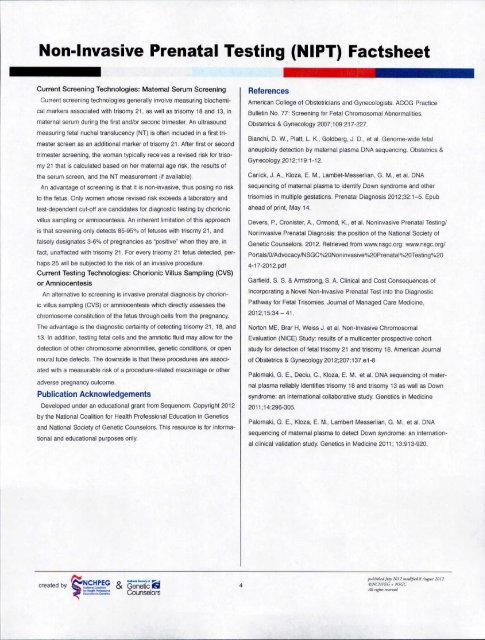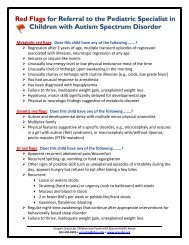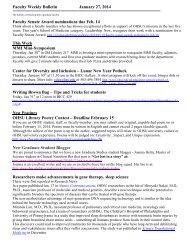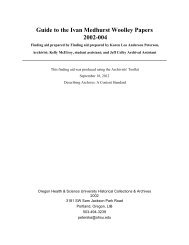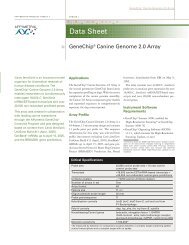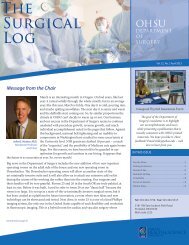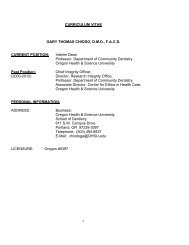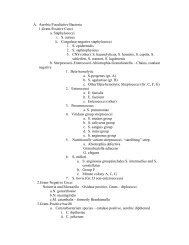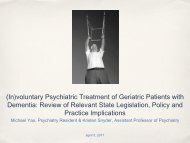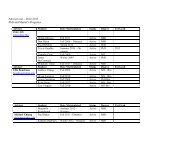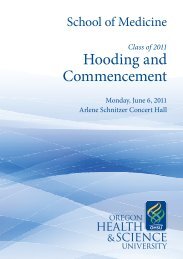Non-Invasive Prenatal Testing (NIPT) Faetsheet
Non-Invasive Prenatal Testing (NIPT) Faetsheet
Non-Invasive Prenatal Testing (NIPT) Faetsheet
Create successful ePaper yourself
Turn your PDF publications into a flip-book with our unique Google optimized e-Paper software.
<strong>Non</strong>-<strong>Invasive</strong> <strong>Prenatal</strong> <strong>Testing</strong> (<strong>NIPT</strong>) <strong>Faetsheet</strong><br />
Current Screening Technologies: Matemal Serum Screening<br />
Current screening technologies generally involve measuring biochemi.<br />
cal markers associated with trisomy 21, as well as trisomy 18 and 13, in<br />
maternal serum during the first and/or secane trimester. An ultrasound<br />
measuring letal nuchal translucency (NT) is often included in a first trio<br />
mester screen as an additional marker 01 trisomy 21. After firsl or second<br />
trimester screening, the woman typically receves a revised risk for triso-<br />
my 21 that is calculated based on her maternal age risk, the results of<br />
the serum screen, and the NT measurement .:.1available)<br />
An advantage 01 screening is that it is non-invasive, thus posing no risk<br />
to the felus. Only women whose revised risk exceeds a laboratory and<br />
test-dependent cut-off are candidates tor diagnostic testing by chorionic<br />
villus sampling or amniocentesis, An inherent limitation of this approach<br />
is that screening only detects 85-95% olletuses with triscmy 21, and<br />
falsely designates 3-6% of pregnancies as .positive~ when they are, in<br />
fact, unaffected with trisomy 21. For every trisomy 21 fetus detected, per-<br />
haps 25 Mil be subjected to the risk of an inv3sive procedure.<br />
Current <strong>Testing</strong> Technologies: Chorionic Villus Sampling (CVS)<br />
or Amniocentesis<br />
An alternative to screening is invasive prenatal diagnosis by chorion-<br />
ic villus sampling (CVS) or amniocentesis which directly assesses the<br />
chromosome constitLtion of the fetus through cells from the pregnancy.<br />
The advantage is the diagnostic certainty at cetecting trisomy 21, 18, and<br />
13. In addition, testing fetal cells and the amniotic fluid may allow for the<br />
detection of other chromosome abnormities, genetic conditions, or open<br />
neural tube defects. The downside is that these procedures are associ-<br />
ated with a measurable risk of a procedure-related miscarriage or other<br />
adverse pregnancy outcome.<br />
Publication Acknowledgements<br />
Developed under an educational grant from Sequenom. Copyright 2012<br />
by the National Coalition for Health Professional Education in Genetics<br />
and National Society of Genetic Counselors. This resource is for informa-<br />
tional and educational purposes only.<br />
f::!- ._-<br />
created by ~t!.S~G&<br />
_.-<br />
-_..~<br />
Genetic",,"<br />
Counselors<br />
4<br />
References<br />
American College of Obstetricians and Gynecologists. ACOG Practice<br />
Bulletin No. 77: Screening for Fetal Chromosomal Abnormalities.<br />
Obstetrics & Gynecology 2007;109:217-227.<br />
Bianchi, O. w., Platt, L. K., Goldberg, J. D., et al. Genome-wide fetal<br />
aneuploidy detection by maternal plasma DNA sequencing. Obstetrics &<br />
Gyoecology 2012:119:1-12.<br />
Car:ick, J. A., Klola, E. M., Lambet-Messerlian, G. M., et a!. DNA<br />
sequencing of maternal pla::ma to identity Down syndrome and other<br />
trisomies in multiple gestaticns. Prenata: Diagnosis 2012;32:1-5, Epub<br />
ahead of print, May 14.<br />
Devers, P., Cronister, A, Ormond, K., et al. <strong>Non</strong>invasive <strong>Prenatal</strong> <strong>Testing</strong>l<br />
Nor-invasive <strong>Prenatal</strong> Diagn"sis: the position of the National SOciety of<br />
Genetic Counselors. 2012. Retrieved from www.nsgc.org: www.~sgc.org/<br />
PortalsIO/AdvocacyINSGC%20<strong>Non</strong>invaslve%20<strong>Prenatal</strong>%20<strong>Testing</strong>%20<br />
4-17-2012.pdf<br />
Garfield, S. S. & Armstrong, S. A. Clinical and Cost Consequences of<br />
Incorporating a Novel <strong>Non</strong>-<strong>Invasive</strong> <strong>Prenatal</strong> Test int:>the Diagnostic<br />
Pathway for Fetal Trisomies, Journal of Managed Care Medicine,<br />
2012;15:34 - 41.<br />
Norton ME, Brar H, Weiss J, et al. <strong>Non</strong>-<strong>Invasive</strong> Chromosomal<br />
Evaluation (NICE) Study: results of a multicenter prospective cohort<br />
study for detection of fetal trisomy 21 and trisomy 18. American Journal<br />
of Obstetrics & Gynecology 2012;207:137.el-8<br />
Palomaki, G. E., Deciu, C., Klola, E. M" et al. DNA sequencing 01 mater-<br />
nal plasma reliably identifie:: trisomy 18 and trisomy 13 as well as Down<br />
syndrome: an international collaborative study. Genetics in Medicine<br />
2011 :14:296-305.<br />
Palomaki, G. E., Klola, E. M., Lambert Messerlian, G. M., et a1.DNA<br />
sequencing of maternal pla::ma to detect Down syndrome: an internation-<br />
al clinical validation study. Genetics in Medicine 2011; 13:913.920.<br />
p"Ohlkd 1"1] 2012 ",,,dituJ 8.~Ii!,"J20ll<br />
eSCHl'EG • N5GC<br />
A1J nr!>n mI71m


